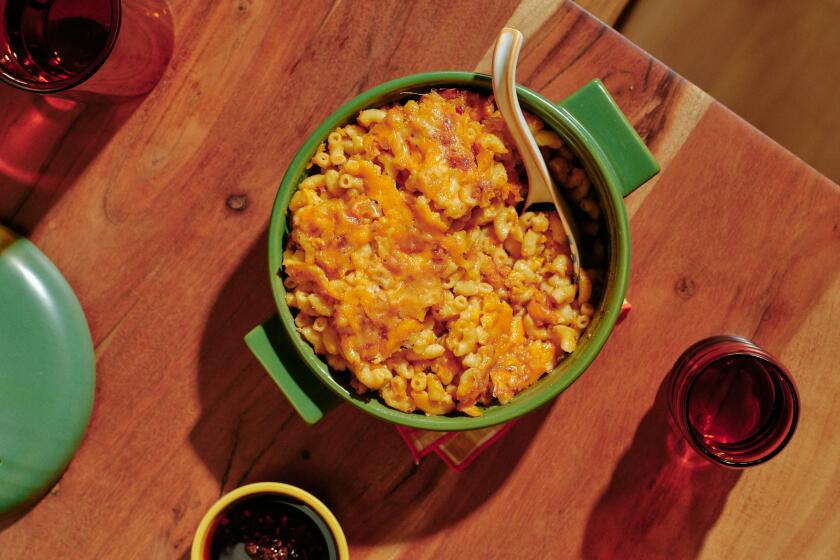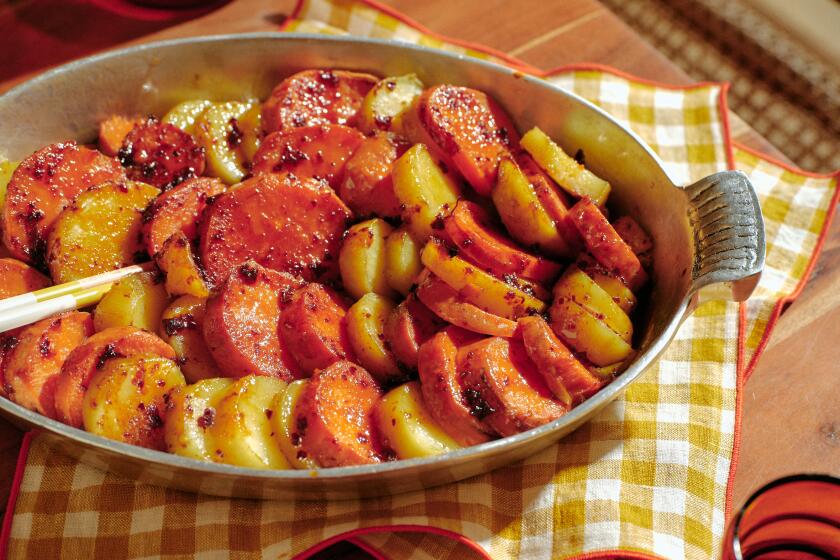Andouille smoked sausage dressing

At first glance, it looks like a roast turkey on steroids. Slice into it and there’s layer after layer of meats and stuffings. It’s a glorious monster of a roast, a guaranteed showstopper at any holiday dinner. Forget Dickens’ prized turkey -- this bird is big enough to crush Tiny Tim. Just make sure you’ve reinforced the dining room table before you set it out.
I’m talking about turducken.
Although traditional roasts, hams and turkeys bring a nice Norman Rockwell-esque feel to the holiday table, they can get to be a bit . . . traditional. Even boring. To try to get around that, I’ve smoked turkeys, roasted game birds, prepared venison and elk steaks, and stuffed or deep-fried almost everything imaginable. I once even made a massive pate en croute -- from bear.
But for me, nothing beats the turducken, and I’ve made at least one every holiday for several years now.
You’ve probably heard the name and may have even seen one on TV. Simply put, a turducken is a glorious meat-fest, consisting of a boned and stuffed chicken placed inside a boned and stuffed duck, which is itself placed inside an at least partially boned and stuffed turkey.
As for its origins, the debate continues. Depending on the source, the turducken might be the creation of chef Paul Prudhomme, or it may have originated at Hebert’s Specialty Meats in Maurice, La., a shop that has sold turduckens since 1985.
But though the turducken itself might be a relatively new idea, the concept is not. Birds have been boned and stuffed throughout much of culinary history and over a wide range of ethnic and regional cuisines. The art was formally refined in classical French cuisine, which gave us galantines and ballotines. (The 19th century “Roti sans Pareil” or “Roast without Equal” consisted of 17 stuffed birds ranging from a bustard to a tiny garden warbler.)
Regardless of its formal origin, the turducken has slowly gained a foothold in the culinary landscape. For football fans, it used to be that the season just wasn’t complete without announcer John Madden and his turducken. Channel-surf and you can still occasionally catch Prudhomme’s how-to video around the holidays.
And of course you can buy your very own turducken from any of a number of sources -- Heberts’ alone sells thousands a year.
But have you ever thought about making your own?
--
The right stuff
It’s not impossible, but I will be honest with you: Making a turducken takes dedication and patience -- lots of patience. That said, nothing beats the satisfaction of presenting your own creation. Plus, you can choose whatever stuffings you want and assemble your masterpiece exactly as you like. This is your (very big) baby.
When it comes to stuffing, I like to make three, one type for each layer of poultry, but you can make just one or two if you prefer. Depending on the size of your turducken, you’ll probably want anywhere between 8 and 12 cups. Don’t make it too moist, and give the stuffing enough time to chill before assembling, preferably a day in advance. My chilled stuffing generally has the consistency of thick cement.
The day before you plan to cook, bone the poultry. Give yourself plenty of time and elbow room, and use a sharp boning knife. I like to work on a large cutting board, placing it either in a very large baking sheet or on a couple of kitchen towels, to soak up any juices as I work.
To start, slice through the back of the chicken down to the backbone and peel the meat away from the bone using your fingers and the tip of a sharp knife. I like to use my fingers whenever possible -- feeling my way along to release the meat from the bone -- but use the knife when needed to make small cuts to detach the meat. The joints are tricky -- I pop them out of the sockets when I can so I can see what I’m doing, gently working my knife around the bones.
Once all of the chicken’s bones have been removed, lay the bird flat, skin side-down, and spoon over a layer of stuffing. Add just enough so you can wrap the chicken lengthwise into a log, and roll the chicken tight, but not overly so. Finally, wrap the log tightly in plastic wrap. Place the chicken in the freezer just long enough to firm it so it holds its shape.
While the chicken is chilling, bone the duck the same way. Add another layer of stuffing, then place the chilled chicken roll (plastic wrap removed) inside the duck. Roll the duck into a log and wrap tightly as before, firming the duck slightly in the freezer as you bone the turkey.
Bone the turkey as you did the chicken and the duck, but leave the wings and drumsticks intact so the turkey retains its familiar shape when it’s rolled. I like to line the turkey with bacon (something I haven’t yet seen with a commercial turducken). Peel the breast meat away from the skin and line the skin with a layer of bacon -- this will help flavor the meat (as if it needs any more) and keep the meat moist as the turducken cooks. Replace the breast meat and line the turkey with stuffing, then stuff with the stuffed duck.
Finally, stitch the turkey closed. Carefully sew the back together (it will look like a “franken-ducken” ) starting from the neck and slowly working down the back, threading and tightening a few stitches at a time (picture a corset).
The turducken will be heavy and unwieldy, so much so that you may need to enlist some help to get it in the roasting pan. The easiest way is to invert a roasting rack and pan over the turkey.
Place one hand under the cutting board on which you’ve assembled the turducken, and the other hand firmly over the roasting pan. Then carefully flip it over. Arrange the turducken in the pan and truss the legs together, then wrap and chill until you’re ready to roast.
--
Now get cooking
On game day, roast the turducken as you would a turkey. I start at 425 degrees to give it a little color, then after 20 minutes reduce the temperature to 325 degrees for the remainder of the roasting time, covering the turducken as needed to prevent it from browning too much. In all, it may take six to eight hours depending on the size of the turducken. (Some recipes call for extended roasting at much lower temperatures). Finally, let the turducken rest a good hour to give the juices time to redistribute.
Roasted and ready to go, wheel this bad boy out to your guests. One thing I’ve always appreciated is that, unlike a turkey that has to be carved, a turducken can be simply sliced like a loaf of bread or a meatloaf. I may be able to make a turducken, but please don’t ask me to carve a turkey -- some things are just too difficult.
In a large skillet, heat the oil over high heat. Stir in 2 cups onions and 1 cup each celery and bell peppers. Saute the vegetables until caramelized, stirring frequently, about 10 to 12 minutes.
Stir in the andouille and cook until the meat is browned, about 5 minutes, stirring frequently. Stir in the remaining 2 cups onions, 1 cup celery and 1 cup bell peppers, along with the butter, garlic and Tabasco. Reduce heat to medium and cook about 3 minutes, stirring occasionally to marry the flavors.
Stir in the stock and bring to a simmer; continue cooking until the oil rises to the top (until the water evaporates), about 10 minutes. Stir in the bread crumbs and remove from heat.
Place the dressing in a baking dish, cover and refrigerate until chilled before stuffing. (To bake the dressing on its own, place it in an ungreased 8-inch-square baking dish; bake uncovered in a 425-degree oven until browned on top, about 45 minutes, stirring and scraping the pan bottom very well every 15 minutes.)
Get our Cooking newsletter.
Your roundup of inspiring recipes and kitchen tricks.
You may occasionally receive promotional content from the Los Angeles Times.
















